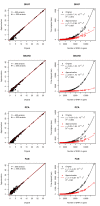sumSTAAR: A flexible framework for gene-based association studies using GWAS summary statistics
- PMID: 35653402
- PMCID: PMC9197066
- DOI: 10.1371/journal.pcbi.1010172
sumSTAAR: A flexible framework for gene-based association studies using GWAS summary statistics
Abstract
Gene-based association analysis is an effective gene-mapping tool. Many gene-based methods have been proposed recently. However, their power depends on the underlying genetic architecture, which is rarely known in complex traits, and so it is likely that a combination of such methods could serve as a universal approach. Several frameworks combining different gene-based methods have been developed. However, they all imply a fixed set of methods, weights and functional annotations. Moreover, most of them use individual phenotypes and genotypes as input data. Here, we introduce sumSTAAR, a framework for gene-based association analysis using summary statistics obtained from genome-wide association studies (GWAS). It is an extended and modified version of STAAR framework proposed by Li and colleagues in 2020. The sumSTAAR framework offers a wider range of gene-based methods to combine. It allows the user to arbitrarily define a set of these methods, weighting functions and probabilities of genetic variants being causal. The methods used in the framework were adapted to analyse genes with large number of SNPs to decrease the running time. The framework includes the polygene pruning procedure to guard against the influence of the strong GWAS signals outside the gene. We also present new improved matrices of correlations between the genotypes of variants within genes. These matrices estimated on a sample of 265,000 individuals are a state-of-the-art replacement of widely used matrices based on the 1000 Genomes Project data.
Conflict of interest statement
The authors have declared that no competing interests exist.
Figures



References
-
- Lee S, Emond MJ, Bamshad MJ, Barnes KC, Rieder MJ, Nickerson DA, et al.. Optimal unified approach for rare-variant association testing with application to small-sample case-control whole-exome sequencing studies. The American Journal of Human Genetics. 2012;91(2):224–37. doi: 10.1016/j.ajhg.2012.06.007 - DOI - PMC - PubMed
-
- Quick C, Wen X, Abecasis G, Boehnke M, Kang HM. Integrating comprehensive functional annotations to boost power and accuracy in gene-based association analysis. PLoS Genet. 2020;16(12):e1009060. doi: 10.1371/journal.pgen.1009060 ; PubMed Central PMCID: PMC7737906 conflicts of interest. - DOI - PMC - PubMed
Publication types
MeSH terms
Grants and funding
LinkOut - more resources
Full Text Sources

